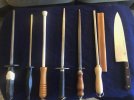- Joined
- Sep 2, 2003
- Messages
- 1,577
Using Steel Hones/Strops To Sharpen A DULL Knife
I was going through my kitchen drawers today and sharpening some of my many neglected chef’s knives. They are an accumulation from over 30 years as a working chef.
As I explored my knife drawers I noticed that there were quite a few “steels” gathering dust too. A couple were “diamond” impregnated, one was ceramic, several others were fine cut, and one was a beautiful polished steel hone. One of the knives I found was an old, unused 10” high carbon Dexter Connoiseur. (see pic) I love the deep belly on those old Dexters. But it had no edge profile and would not slice paper, much less a tomato. It wouldn’t even tear into the edge of a sheet of printer paper. It was a dull knife.
As I was getting ready to profile the edge I decided to see what would happen if I used only the steels to sharpen this old dinosaur?
Now the disclaimers:
I sharpen with an EdgePro, freehand with stones, and often use a Ken Onion Work Sharp to reprofile. I also know that a steel, “sharpening steel”, or steel hone really only realigns the microscopic “wavy” edge on an otherwise sharp-ish knife. But I also had one ceramic and two diamond steels and I was determined to see if I could bring a serviceable edge to the blade using nothing but various steel strops and hones.
Game on.
I first used my old Eze Lap diamond steel. About 30 strokes per side. Then the ceramic steel 30 strokes per side. Then tested paper cutting. I did this three times until the knife began to tear the paper. Then I tried following the diamond and ceramic steels by stropping on a fine cut steel (bit of an improvement) and finally on the polished steel (bit more of an improvement).

I repeated this process until the Dexter would smoothly slice paper. It was a fun experiment and didn't take much more than 30 minutes of actual stropping. Will it shave hair? No. But I think that in a few more repetitions it would – which is a relief because it means I can put back those bastard files. (=
I was going through my kitchen drawers today and sharpening some of my many neglected chef’s knives. They are an accumulation from over 30 years as a working chef.
As I explored my knife drawers I noticed that there were quite a few “steels” gathering dust too. A couple were “diamond” impregnated, one was ceramic, several others were fine cut, and one was a beautiful polished steel hone. One of the knives I found was an old, unused 10” high carbon Dexter Connoiseur. (see pic) I love the deep belly on those old Dexters. But it had no edge profile and would not slice paper, much less a tomato. It wouldn’t even tear into the edge of a sheet of printer paper. It was a dull knife.
As I was getting ready to profile the edge I decided to see what would happen if I used only the steels to sharpen this old dinosaur?
Now the disclaimers:
I sharpen with an EdgePro, freehand with stones, and often use a Ken Onion Work Sharp to reprofile. I also know that a steel, “sharpening steel”, or steel hone really only realigns the microscopic “wavy” edge on an otherwise sharp-ish knife. But I also had one ceramic and two diamond steels and I was determined to see if I could bring a serviceable edge to the blade using nothing but various steel strops and hones.
Game on.
I first used my old Eze Lap diamond steel. About 30 strokes per side. Then the ceramic steel 30 strokes per side. Then tested paper cutting. I did this three times until the knife began to tear the paper. Then I tried following the diamond and ceramic steels by stropping on a fine cut steel (bit of an improvement) and finally on the polished steel (bit more of an improvement).

I repeated this process until the Dexter would smoothly slice paper. It was a fun experiment and didn't take much more than 30 minutes of actual stropping. Will it shave hair? No. But I think that in a few more repetitions it would – which is a relief because it means I can put back those bastard files. (=
Last edited:

